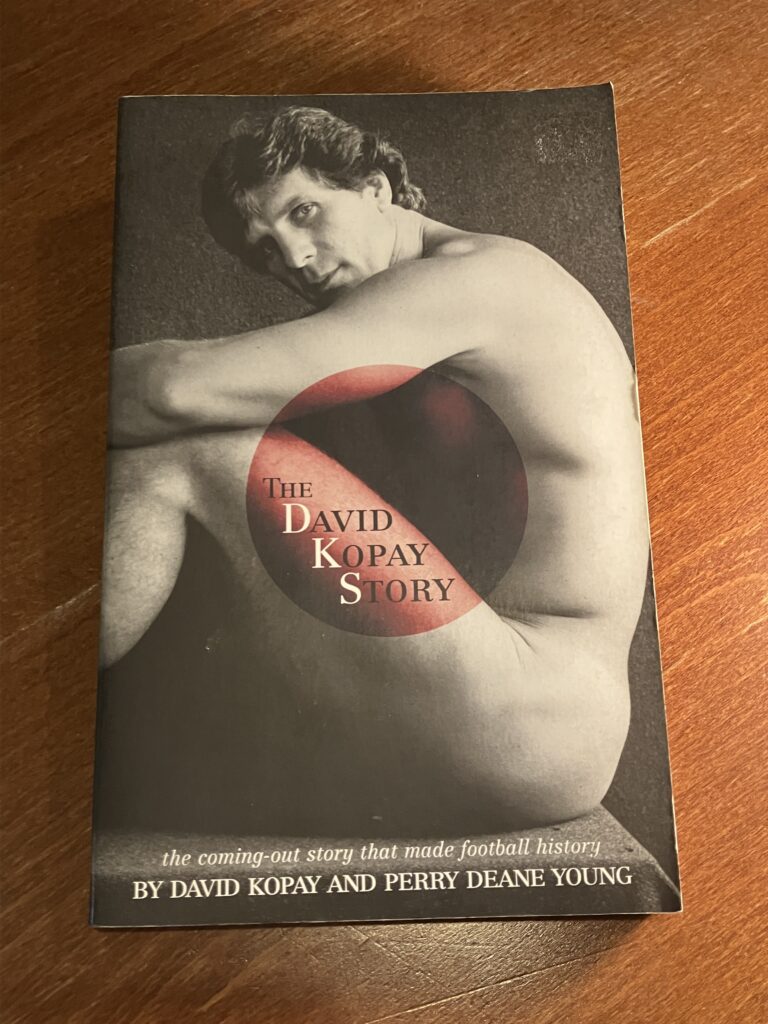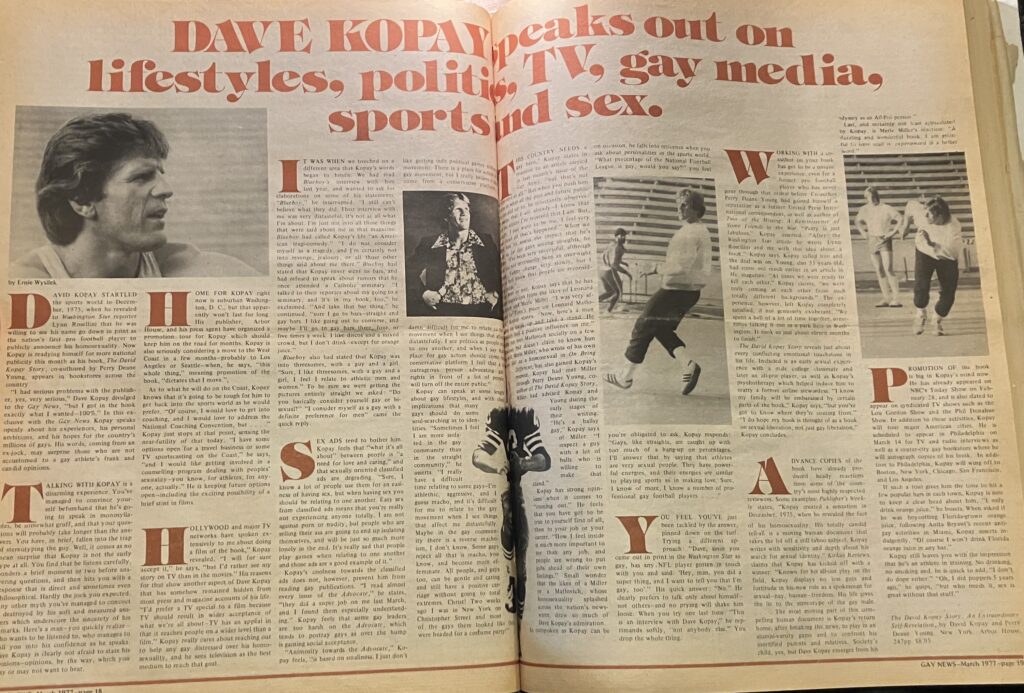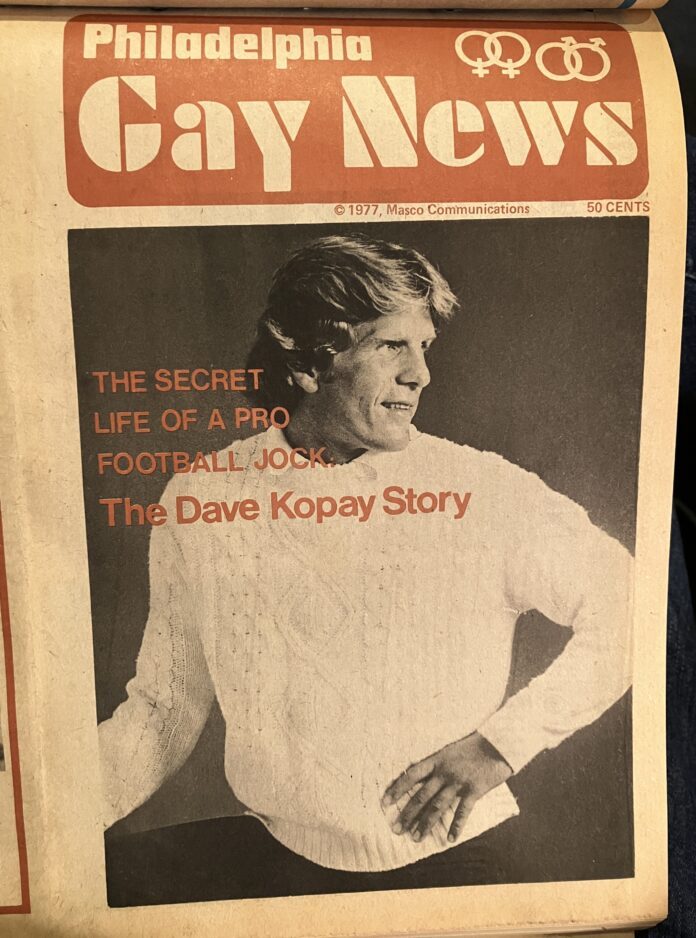When the NFL’s 2022 season began, just one player, Carl Nassib, identified openly as gay. An outside linebacker for the Tampa Bay Buccaneers, Nassib came out in a video posted to his Instagram account in June 2021, making him the first active NFL player to do so.
“I just want to take a quick moment to say that I’m gay,” Nassib said. “I’ve been meaning to do this for a while now, but I finally feel comfortable enough to get it off my chest.”
It was an historic moment. What’s remarkable is that it took almost five decades for it to happen. Because in 1975, David Kopay, a running back who’d played on five different teams before retiring, announced in an interview in “The Washington Star” that he was gay, making him the first former NFL player — or any of America’s four major sports — to come out.
Kopay played professional football from 1964 to 1972, often on special teams. He earned his place on each roster through a combination of gritty determination and physical courage.
An unnamed teammate from the old Washington Redskins summed Kopay up nicely for the “Washington Daily News”: “He enjoys hitting people, he’s got a mean streak and he knows something about these teams.”
By December 1975, however, Kopay was 33 and had been retired for two years. He’d had several false starts in business and no luck finding a coaching job. That’s when he saw reporter Lynn Rosellini’s article in “The Washington Star” titled “Homosexuals in Sports: Why Gay Athletes Have Everything to Lose.”
Rosellini’s article drew a firestorm of criticism. Many complained that she’d given too much weight to anonymous sources.
Reading between the lines, Kopay recognized some of the players Rosellini spoke to. More importantly, he knew that he could make a difference by talking to her on the record.
Kopay’s motivation for speaking out was twofold. His attempts to get a coaching job had been stymied, he felt, by a league-wide homophobia. “Because of my homosexuality I can’t get a job as a coach,” he explained in his memoir.
Kopay had also struggled to come to terms with his romantic and physical attraction to other men. He knew how much better his life could have been if he’d had positive role models. As he put it, “If some of us don’t take on the oppressive labels and publicly prove them wrong, we’ll stay trapped by the stereotypes for the rest of our lives.”

After that initial interview with Rossellini, Kopay wasn’t done. In 1977, he and author Perry Deane Young, who was also gay, published “The David Kopay Story: An Extraordinary Self-Revelation.” The book is both a thoughtful meditation on masculinity, sexuality, and sports, and a candid tell-all.
Kopay was the second of four children born in a working-class household to devoutly Catholic parents. Their marriage was unhappy; he recalls frequent arguments that sometimes turned physical.
During that time, sports offered an outlet to Kopay. But with high school not far off, and wracked by guilt over his burgeoning sexuality, he made the curious decision to enter a junior seminary. His motivation seemed to be twofold: on the one hand, he imagined it as an opportunity to “be good,” and, on the other hand, it offered an escape from an unhappy home. However, with the desire to return to team sports on his mind, he left the seminary after only 18 months.
Kopay became a standout athlete at Notre Dame High School in Sherman Oaks, California, garnering several scholarships. In 1961, he transferred to the University of Washington where, in addition to playing football, he joined the fraternity Theta Chi.
After a promising start to his college sports career, Kopay faltered on the gridiron. It was partly confusion over his sexuality. He was smitten by a fraternity brother whom he calls “Ted Robinson” in his book. The two hung out, got drunk, and double-dated girls. But after dropping off their dates, the two young men would fool around.
“Beneath Ted’s horseplay and all our silliness, of course, there were deeper feelings,” Kopay wrote. “Ted was somebody who seemed to respond to me with a special warmth, and that was something I had never known in a friend. It felt good just being with him.”
Kopay pulled himself together for his senior year, leading the Huskies to the Rose Bowl in 1964. He was named an All-American and got an offer to try out for the San Francisco 49ers.
Kopay’s account of his time in the NFL is curious. On the one hand, he describes a relentless focus on football. And, on the other, he describes being increasingly anxious about his burgeoning sexuality. The more he acknowledges his attraction to other men, the more he worries about losing his job. The worry isn’t unfounded.
As Tom Dowling wrote in his book, “Coach: A Season with Lombardi,” the NFL was hardly accepting of gay men. “Love beads and long hair are considered depraved by the average football coach,” Dowling noted, “and homosexuality a crime of almost unspeakable dimensions.”
Kopay doesn’t spare himself. He acknowledges mistakes, like getting entangled with a quack psychiatrist and marrying a woman even though he knew he was gay.
Perhaps the most difficult story Kopay relates is his encounter with a teammate, whom he calls “Bill Stiles,” an All-Pro tight end who was also gay. (Bill was later revealed to be Jerry Smith, who died from AIDS in 1986.)
The two men became close and eventually spent an evening together. But Kopay was so ignorant of the mechanics of gay sex that Bill left in frustration and treated him frostily afterwards. Kopay was devastated
“Now I thought I had found a real relationship. I was ready to be lovers for life. I worshiped the man. He rejected me cold,” Kopay wrote.
Slowly but surely, Kopay begins to live openly as a gay man. His coming out, however, alienated his family. His mother and brother Tony were particularly upset. According to Kopay, after telling his mother, she said, “I created you and I can destroy you.”
Despite that, the book ends on a hopeful note. “It’s a new life for me now — without football, living openly as a homosexual. But I’m facing it with the strength of an honest man. And that’s got to be a good beginning,” Kopay wrote.
The NFL might not have wanted to talk about its gay athletes, but plenty of others did. Kopay’s book spent ten weeks on “The New York Times” best-seller list. He was a guest on the “Phil Donahue Show,” the “Tomorrow Show” with Tom Snyder, NBC’s “Today Show” and the “David Susskind Show.” He even appeared on the cover of “Mandate” magazine in May 1977.
In a feature in Philadelphia Gay News shortly after the book’s release, Kopay said he drew inspiration from Air Force Sergeant Leonard Matlovich and writer Merle Miller, who also had very public coming out experiences. “I was very affected by TIME’s piece on Leonard Matlovich,” Kopay said. “Now, here’s a man willing to speak up and take a stand. He definitely had a positive influence on me.”

After a cross country book tour, Kopay moved to San Francisco, where he’d begun his NFL career in 1964. Although he’d played three seasons with the 49ers, he’d been deeply conflicted about his sexuality then.
“For four years I lived within minutes of the great gay capital of San Francisco and never had a real homosexual experience,” Kopay noted in his book.
Kopay’s experience of San Francisco was much different this time. He was befriended by Harvey Milk, the openly gay city supervisor, and Randy Shilts, the gay journalist who wrote “And the Band Played On.” He was even roommates with the novelist Armistead Maupin, the author of “Tales of the City.”
“I loved walking into bars with Dave,” Maupin later recalled in a GQ feature on Kopay, “because you could watch every head turn. He was a major babe and a hero to every gay person.”
Eventually, the brouhaha surrounding Kopay’s book subsided. And when no coaching job materialized, he joined his uncle’s business, Linoleum City, a Hollywood flooring company.
Kopay stayed with the family business until retiring. It may not have been the football career he originally wanted, but it enabled him to give back to the LGBT community.
In September 2008, Kopay pledged $1 million to the University of Washington’s Q Center, which supports LGBTQ students and faculty. As he told a reporter for the UW alumni magazine, “I wanted to do something meaningful, to leave something behind that would benefit people whose experiences and feelings I shared and can understand.”
When asked about what he would feel watching Carl Nassib play in the NFL as an openly gay man, Kopay told Outsports in September 2021, “It will be emotional, hugely emotional.”
“There’s a few of us that paved the way and it makes me incredibly happy.”
